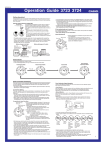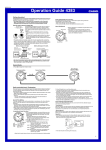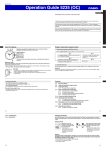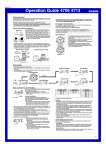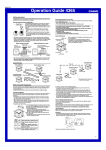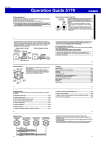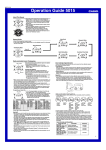Download Casio 4326 Watch User Manual
Transcript
MO0708-EA Operation Guide 4325 4326 Getting Acquainted Congratulations upon your selection of this CASIO watch. To get the most out of your purchase, be sure to read this manual carefully. Bright light The electricity generated by the solar cell of the watch is stored by a built-in battery. Leaving or using the watch where it is not exposed to light causes the battery to run down. Make sure the watch is exposed to light as much as possible. • When you are not wearing the watch on your wrist, position the face so it is pointed at a source of bright light. • You should try to keep the watch outside of your sleeve as much as possible. Even if the face of the watch is blocked only partially from light, charging will be reduced significantly. l l l l l l l l l l l Keep the watch exposed to bright light Solar cell • The actual level at which some functions are disabled depends on the watch model. • Be sure to read “Power Supply” for important information you need to know when exposing the watch to bright light. If the analog hands aren’t moving... If the analog hands aren’t moving, it means that the power saving mode has stopped them to save battery power. • See “Power Saving” for more information. • The hands also stop whenever the battery level reaches Level 2. About This Manual Hour hand Minute hand • The watch continues to operate, even when it is not exposed to light. Leaving the watch in the dark can cause the battery to run down, which will cause some watch functions to be disabled. If the battery goes dead, you will have to re-configure watch settings after recharging. To ensure normal watch operation, be sure to keep it exposed to light as much as possible. Battery charges in the light. Solar cell (Converts light to electrical power.) • Button operations are indicated using the letters shown in the illustration. • Each section of this manual provides you with the information you need to perform operations in each mode. Further details and technical information can be found in the “Reference” section. Battery discharges in the dark. Second hand Bright light All functions disabled. Electrical energy LEVEL 1 Charge LEVEL 2 All functions enabled. Dis- LEVEL 1 charge LEVEL 2 Rechargeable battery General Guide • This watch is designed so the function of a button is executed when you release the button, not when you press it. • Use A and B to change from mode to mode as shown below. Manual Receive Home Position Adjustment Mode Receive Result Mode Timekeeping Mode Press A. ▲ ▲ Press any button. ▲ ▲ Hold down A for about two seconds. ▲ While holding down B, hold down A for about five seconds. ▲ Press A twice. Radio-controlled Timekeeping This watch receives a time calibration signal and updates its time setting accordingly. The time calibration signal includes both Standard Time and Daylight Saving Time (summer time) data. • This watch switches automatically between Standard Time and Daylight Saving Time in accordance with the time calibration signal it receives. There is no indicator showing whether the time currently shown by the watch is Standard Time or Daylight Saving Time. • This watch is designed to pick up the time calibration signal transmitted in Germany (Mainflingen) and England (Anthorn). • See the information under “Signal Reception Troubleshooting” if you experience problems with time calibration signal reception. Current Time Setting This watch adjusts its time setting automatically in accordance with a time calibration signal. You also can perform a manual procedure to set the time, when necessary. • The first thing you should do after purchasing this watch is to specify a GMT differential, which is the time differential between GMT and the location where you normally will use the watch. For more information, see “To specify a GMT differential” below. • When using the watch outside the range of the Germany and England time signal transmitters, you have to adjust the current time setting manually as required. See “Timekeeping” for more information about manual time settings. To specify a GMT differential 1. In the Timekeeping Mode, hold down B for about five seconds until the second hand moves to the currently GMT GMT selected GMT differential setting and stops. This is the differential differential setting mode. value (+0) value (+1) • The GMT differential value indicates the time GMT difference in hours from Greenwich Mean Time. differential 2. Use A to move the second hand to the GMT value (+2) differential setting you want to use. GMT +0 (12 o’clock): London GMT +1 (1 o’clock): Paris, Berlin, Milan, Rome, Amsterdam, Hamburg, Frankfurt, Vienna, Barcelona, Madrid GMT +2 (2 o’clock): Athens 3. Press B to exit the setting mode. • The watch also will return to the Timekeeping Mode if you do not perform any operation for about two or three minutes. • Normally, your watch should show the correct time as soon as you select a GMT differential. If it does not, it should adjust automatically after the next auto receive operation (in the middle of the night). You can also perform manual receive or you can set the time manually. • Even if the time calibration signal is received correctly, there are some times when the analog hands may not indicate the correct time. If this happens, use the procedures under “Adjusting the Home Positions” to check the home positions of the hands, and make adjustments as required. • The watch will receive the time calibration signal automatically from the applicable transmitter (in the middle of the night) and update its settings accordingly. For information about the relationship between GMT differential values and transmitters, see “Transmitters”. • See the maps under “Approximate Reception Ranges” for information about the reception ranges of the watch. Time Calibration Signal Reception There are two different methods you can use to receive the time calibration signal: auto receive and manual receive. • Auto Receive With auto receive, the watch receives the time calibration signal automatically up to six times a day. When any auto receive is successful, the remaining auto receive operations are not performed. For more information, see “About Auto Receive”. • Manual Receive Manual receive lets you start a time calibration receive operation with the press of a button. For more information, see “To perform manual receive”. Important! • When getting ready to receive the time calibration signal, position the watch as shown in the nearby illustration, with its 12 o’clock side facing towards a window. Make sure there are no metal objects nearby. 12 o’clock or • Make sure the watch is facing the right way. • Proper signal reception can be difficult or even impossible under the conditions listed below. Inside or among buildings Inside a vehicle Near household appliances, office equipment, or a mobile phone Near a construction site, airport, or other sources of electrical noise Near hightension power lines Among or behind mountains 1 Operation Guide 4325 4326 • Signal reception normally is better at night than during the day. • Time calibration signal reception takes from two to seven minutes, but in some cases it can take as long as 14 minutes. Take care that you do not perform any button operations or move the watch during this time. • When within range of the applicable transmitter, this watch can receive either the Germany (Mainflingen) or England (Anthorn) time calibration signals. See “Transmitters” for more information. Approximate Reception Ranges 1,500 kilometers Anthorn To check the latest signal reception results Enter the Receive Result Mode. • If the watch was able to perform a successful signal receive operation since midnight, the second hand will move to Y (YES). If the watch has been unable to receive any signal successfully, the second hand will move to N (NO). • To return to the Timekeeping Mode, press A. • The current receive result is cleared when the first auto receive operation is performed on the following day. This means Y (YES) indicates successful signal reception Y since the start of the current day. N • If you have adjusted the time setting manually, the second hand will indicate N (NO) here. Signal Reception Troubleshooting Check the following points whenever you experience problems with signal reception. 500 kilometers Mainflingen • At distances further than about 500 kilometers from a transmitter, signal reception may not be possible during certain times of year or times of day. Radio interference also may cause problems with reception. • Even when the watch is within the reception range of the transmitter, signal reception will be impossible if the signal is blocked by mountains or other geological formations between the watch and signal source. • Signal reception is affected by weather, atmospheric conditions, and seasonal changes. Problem The second hand is pointing at N (NO). Probable Cause • You changed the time setting manually. • Manual signal reception failed for some reason. • The watch was not in the Timekeeping Mode, or you performed some button operation during the auto receive operation. • Signal reception results are reset at midnight each day. Time setting • The GMT differential setting is not is incorrect correct for the area where you are following using the watch. signal • The home position of the hands is off. reception. What you should do • Perform manual signal receive or wait until the next auto signal receive operation is performed. • Check to make sure the watch is in a location where it can receive the signal. • Select the correct GMT differential. • Enter the Home Position Adjustment Mode and adjust the home position. About Auto Receive The watch receives the time calibration signal automatically up to six times a day. When any auto receive is successful, the remaining auto receive operations are not performed. The reception schedule (calibration times) depends on the currently selected GMT differential, and whether standard time or Daylight Saving Time is selected for it. • For further information, see “Important!” under “Time Calibration Signal Reception” and “Radio-controlled Timekeeping Precautions”. GMT Differential Adjusting the Home Positions Auto Receive Start Times 1 2 3 4 5 6 GMT +0 Standard Time 1:00 am 2:00 am 3:00 am 4:00 am 5:00 am Midnight Daylight Saving Time 2:00 am 3:00 am 4:00 am 5:00 am Midnight 1:00 am next day GMT +1 Standard Time 2:00 am 3:00 am 4:00 am 5:00 am Midnight 1:00 am next day Daylight Saving Time 3:00 am 4:00 am 5:00 am Midnight 1:00 am 2:00 am next day next day GMT +2 Standard Time 3:00 am 4:00 am 5:00 am Midnight 1:00 am 2:00 am next day next day Daylight Saving Time 4:00 am 5:00 am Midnight 1:00 am 2:00 am 3:00 am next day next day next day Note • The auto receive operation is performed only if the watch is in the Timekeeping Mode when one of the calibration times is reached. It is not performed if a calibration time is reached while you are configuring settings. • Auto receipt of the calibration signal is designed to be performed early in the morning, while you sleep (provided that the Timekeeping Mode time is set correctly). Before going to bed for the night, remove the watch from your wrist, and put it in a location where it can receive the signal easily. • The watch receives the calibration signal for two to seven minutes everyday when the time in the Timekeeping Mode reaches each of the calibration times. Do not perform any button operation within seven minutes before or after any one of the calibration times. Doing so can interfere with correct calibration. • Remember that reception of the calibration signal depends on the current time in the Timekeeping Mode. The receive operation will be performed whenever the display shows any one of the calibration times, regardless of whether or not the displayed time actually is the correct time. To perform manual receive 1. Place the watch on a stable surface so its 12 o’clock side is facing towards a window. 2. In the Timekeeping Mode, hold down A for about two seconds until the second hand moves to READY (R). This indicates that the watch is getting ready to receive the time calibration signal. • The second hand will move to WORK (W) and stay there while actual reception is in progress. WORK READY • The hour and minute hands continue to keep time normally. • Time calibration signal reception takes from two to seven minutes, but in some cases it can take up to 14 minutes. Take care that you do not perform any button operations or move the watch during this time. • If reception is successful, the second hand will move to Y (YES). One or two minutes later, the hands will move to the correct time. Y N Note • To interrupt a receive operation and return to the Timekeeping Mode, press any button. • If reception is not successful, the second hand will move to N (NO). One or two minutes later, the second hand will resume normal operation, without any adjustment of the hand setting. • If the second hand is pointing to Y (YES) or N (NO), you can return to the Timekeeping Mode by pressing any button. Viewing the Latest Signal Reception Results You can use the Receive Result Mode to check if signal reception was performed correctly. If the time settings are wrong even after the time calibration signal is received normally, use the following procedure to adjust their home positions. To adjust the home positions 1. Enter the Home Position Adjustment Mode. 12 o’clock • If the home position of the second hand currently is correct, it will move to the 12 o’clock position. • The analog hands do not keep time during home position adjustment. 2. Check the position of the second hand. • The second hand home position is correct if it is pointing at 12 o’clock. • If the second hand is not pointing at 12 o’clock, it means that its home position is off. If this happens, press B to move the second hand clockwise in onesecond steps, until it points at 12 o’clock. Correct second hand 3. Press A to advance to hour and minute hand home home position position adjustment. 12 o’clock • If current hour and minute hand alignment is correct, they will both move to 12 o’clock. 4. Check the position of the hour and minute hands. • If the hour and minute hands are not pointing at 12 o’clock, it means that their home position is off. If this happens, press B to move the hour and minute hands clockwise in 10-second steps, until they point at 12 o’clock. 5. Press A to exit home position adjustment. • This will cause the watch to return to the Timekeeping Mode. The hour, minute and second hands will indicate Correct hour the current time. and minute hand • Note that all button operations are disabled while the home position hour and minute hands are moving. • After you complete the home position adjustment procedure, place the watch in a location that allows good time calibration signal reception, and then perform a manual receive operation. See “To perform manual receive” for more information. Timekeeping Hour hand Minute hand Use the Timekeeping Mode to set and view the current time. This section also explains how to set the current time manually. • If you become confused and lose your way during the following procedures, simply put the watch down and do not perform any button operation for two or three minutes. This will cause the watch to enter the Timekeeping Mode (indicated by normal one-second movement of the second hand) automatically. After that, you can try performing the manual setting procedure again from the beginning. Second hand To adjust the time setting manually 1. In the Timekeeping Mode, hold down A for about five seconds. AM • This operation causes the second hand to move to AM or PM PM in accordance with the current time setting. This is the setting mode. • The hour and minute hands do not move in the setting mode. 2. Press B to move the time setting forward by one minute. • Holding down B for about two seconds starts high-speed hand movement. High-speed hand movement will continue until the hands complete a 12-hour cycle, or until you stop them by pressing B. • If you exit the setting mode after changing the time setting, the second hand will restart timing from 12 o’clock (0 seconds) automatically. • The AM/PM setting will not change even if you move the hour hand past 12 o’clock in step 2. Use step 3 below to switch between AM and PM. 2 Operation Guide 4325 4326 This watch is equipped with a solar cell and a special rechargeable battery (secondary battery) that is charged by the electrical power produced by the solar cell. The illustration shown below shows how you should position the watch for charging. Solar cell Example: Orient the watch so its face is pointing at a light source. • The illustration shows how to position a watch with a resin band. • Note that charging efficiency drops when any part of the solar cell is blocked by clothing, etc. • You should try to keep the watch outside of your sleeve as much as possible. Even if the face of the watch is blocked from light only partially, charging will be reduced significantly. Approximate Exposure Time Level 2 Level 1 Outdoor sunlight (50,000 lux) Sunlight through a window (10,000 lux) Daylight through a window on a cloudy day (5,000 lux) Indoor fluorescent lighting (500 lux) 3 hours 19 hours 9 hours 68 hours 14 hours 110 hours 146 hours ––– • The above exposure time values are all for reference only. Actual required exposure times depend on lighting conditions. Reference This section contains more detailed and technical information about watch operation. It also contains important precautions and notes about the various features and functions of this watch. Auto Return Features • If you leave the watch in the Home Position Adjustment Mode and Receive Result Mode for two or three minutes without performing any operation, it will return to the Timekeeping Mode automatically. • If you do not perform any operation for about two or three minutes while a setting mode is selected, the watch will exit the setting mode automatically. High-speed Hand Movement Important! • Storing the watch for long periods in an area where there is no light or wearing it in such a way that it is blocked from exposure to light can cause rechargeable battery power to run down. Make sure that the watch is exposed to bright light whenever possible. • This watch uses a special rechargeable battery to store power produced by the solar cell, so regular battery replacement is not required. However, after very long use, the rechargeable battery may lose its ability to achieve a full charge. If you experience problems getting the special rechargeable battery to charge fully, contact your dealer or CASIO distributor about having it replaced. • Never try to remove or replace the watch’s special battery yourself. Use of the wrong type of battery can damage the watch. • The current time and all other settings return to their initial factory defaults whenever battery power drops to Level 2 and when you have the battery replaced. • Keep the watch in an area normally exposed to bright light when storing it for long periods. This helps to keep the rechargeable battery from going dead. Battery Power Levels The movement of the analog hands indicates the current battery power level. Level Exposure Level (Brightness) ▲ Power Supply Recovery Times The table below shows the amount exposure that is required to take the battery from one level to the next. ▲ 3. Press A to advance to AM/PM switching. • This will cause the second hand to perform one full rotation starting from its current position (either AM or PM), and then stop at its original current position. 4. Press B to toggle the second hand between AM and PM. 5. Coordinating with a time signal on the radio or TV, press A to restart normal timekeeping. The second hand will move to 12 o’clock (zero seconds) at the start of timekeeping. • If you press A without changing the time setting (hour, minute, AM/PM), the second hand will move to the current time position and timekeeping will resume from there. • This watch normally receives a time calibration signal late at night. However, if you configure the wrong AM/PM setting in step 3 of the above procedure, the watch will start signal reception automatically during the afternoon. Signal reception during the day is not as good as nighttime reception, so a wrong AM/PM setting can cause signal reception problems. Hand Movement Function Status 1 Normal. All functions enabled. 2 All hands stop at 12 o’clock. All functions disabled. • The B button is used to change the hand setting in various setting modes. In most cases, holding down the B button will start high-speed movement of the applicable hand(s). • High-speed movement of the hands will continue until it completes a 12-hour cycle, or until you press any button to stop it. Radio-controlled Timekeeping Precautions • Strong electrostatic charge can result in the wrong time being set. • The time calibration signal bounces off the ionosphere. Because of this, such factors as changes in the reflectivity of the ionosphere, as well as movement of the ionosphere to higher altitudes due to seasonal atmospheric changes or the time of day may change the reception range of the signal and make reception temporarily impossible. • Even if the time calibration signal is received properly, certain conditions can cause the time setting to be off by up to one second. • The current time setting in accordance with the time calibration signal takes priority over any time settings you make manually. • If you are in an area where proper time calibration signal reception is impossible, the watch keeps time within ±20 seconds a month at normal temperature. • If you have problems with proper time calibration signal reception or if the time setting is wrong after signal reception, check the GMT differential setting. The initial factory default GMT differential setting is GMT +1 (Module 4325) or GMT +0 (Module 4326). Transmitters This watch is able to receive time calibration signals transmitted in Germany (Mainflingen) and England (Anthorn). The following explains how the watch determines which transmitter it should check first. When GMT differential GMT+1 or GMT+2 is selected: • When all hands stop at 12 o’clock (Level 2), it means that battery power is quite low. Expose the watch to light as soon as possible to charge the battery. • When battery power is at Level 2, time calibration signal reception is disabled. • At Level 2, all functions are disabled and settings return to their initial factory defaults. • Even if the battery level drops to point that all functions become disabled, you still will be able to recharge the battery and use the watch again. Charging Precautions In this case: The watch does this: The first signal search operation after the GMT differential setting has been changed 1. Checks the Mainflingen signal first. 2. If the Mainflingen signal cannot be received, checks the Anthorn signal. The second and subsequent signal searches 1. Checks the signal of the transmitter of the first receive operation (Anthorn or Mainflingen). 2. If the checked signal cannot be received, checks the other signal. Certain charging conditions can cause the watch to become very hot. Avoid leaving the watch in the areas described below whenever charging its rechargeable battery. Warning! Leaving the watch in bright light to charge its rechargeable battery can cause it to become quite hot. Take care when handling the watch to avoid burn injury. The watch can become particularly hot when exposed to the following conditions for long periods. • On the dashboard of a car parked in direct sunlight • Too close to an incandescent lamp • Under direct sunlight When GMT differential GMT+0 is selected: In this case: The watch does this: The first signal search operation after the GMT differential setting has been changed 1. Checks the Anthorn signal first. 2. If the Anthorn signal cannot be received, checks the Mainflingen signal. The second and subsequent signal searches 1. Checks the signal of the transmitter of the first receive operation (Anthorn or Mainflingen). 2. If the checked signal cannot be received, checks the other signal. Charging Guide After a full charge, timekeeping remains enabled for up to about four months. • The following table shows the amount of time the watch needs to be exposed to light each day in order to generate enough power for normal daily operations. Exposure Level (Brightness) Approximate Exposure Time Outdoor sunlight (50,000 lux) 9 minutes Sunlight through a window (10,000 lux) 32 minutes Daylight through a window on a cloudy day (5,000 lux) 51 minutes Indoor fluorescent lighting (500 lux) 8 hours Timekeeping • The current time in the Timekeeping Mode is calculated in accordance with the current Greenwich Mean Time (GMT) differential setting. • GMT differential is calculated by this watch based on Universal Time Coordinated (UTC*) data. * UTC is the world-wide scientific standard of timekeeping. It is based upon carefully maintained atomic (cesium) clocks that keep time accurately to within microseconds. Leap seconds are added or subtracted as necessary to keep UTC in sync with the Earth’s rotation. The reference point for UTC is Greenwich, England. • Since these are the specs, we can include all the technical details. • Watch is not exposed to light • Internal timekeeping • 6 minutes of signal reception per day • Stable operation is promoted by frequent charging. 3 Operation Guide 4325 4326 Power Saving Power Saving enters a sleep state automatically whenever the watch is left for a certain period in an area where it is dark. The table below shows how watch functions are affected by Power Saving. • There actually are two sleep state levels: “second hand sleep” and “function sleep”. Elapsed Time in Dark Operation 60 to 70 minutes (second hand sleep) Second hand only is stopped, all other functions are enabled. 6 or 7 days (function sleep) • All functions, including analog timekeeping, disabled • Internal timekeeping maintained • Wearing the watch inside the sleeve of clothing can cause it to enter the sleep state. • The watch will not enter the sleep state between 6:00 AM and 9:59 PM. If the watch is already in the sleep state when 6:00 AM arrives, however, it will remain in the sleep state. To recover from the sleep state Perform any one of the following operations. • Move the watch to a well-lit area. • Press any button. 4





